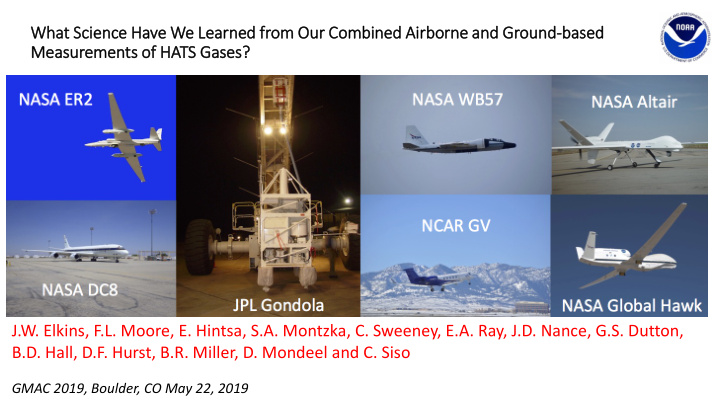



What S t Scien ence H e Have W e We Learned ed f from O Our C Combined ed A Airborne e and G Ground-based ed Measurem emen ents o of H HATS G Gases es? J.W. Elkins, F.L. Moore, E. Hintsa, S.A. Montzka, C. Sweeney, E.A. Ray, J.D. Nance, G.S. Dutton, B.D. Hall, D.F. Hurst, B.R. Miller, D. Mondeel and C. Siso GMAC 2019, Boulder, CO May 22, 2019
Airborne M e Missi ssions and M nd Measu surem emen ents & s & SF 6 Missions started in 1991 for regional polar O 3 loss research studies, covered Pacific ocean, moved to CFC replacements and • shorter lived trace gases with PANTHER, UAS Altair and Global Hawk, and global GHG & chemistry studies. SF 6 added in 1994, identified SF 6 mesospheric sink (3200 yr to 850 yr lifetime). Started atmospheric transport studies. •
An Ex Example f from Tropospheric S Seasonal Surve very: M Measurem emen ents of S f SF 6 on ATmos ospheri ric Tomograp aphy Mission ( (Atom) • ATom had 11-13 flights per circuit (ATom 1-4), 4-9 vertical profiles per flight. • Three airborne GMD instruments ( PANTHER, UCATS, and PFPs ) used GC-ECD and the WMO CCL standard scale on all circuits. • PANTHER and UCATS measured SF 6 once every 70 seconds and not in sync. Twice the data! Total ~7700 obs./circuit. • PFP typically had 1-2 twelve flask packages per flight. ~220 obs./circuit.
Using SF SF 6 as a a Tropospheric C Clock • NOAA GMD ground based network measured SF 6 since 1995 from 3.5 to >10 ppt globally. • Growth rate over the past 5 years was 0.32 ppt yr -1 . Strong N-S gradient. Has lifetime of 850 yr. Great atmospheric clock! • Used in the electric power distribution, large growth in usage in East Asia. • Emitted mainly from 30 to 60 ○ N. • Used to show stratospheric delay of peak EESC of 3 years in midlatitudes and 5 years in polar regions for stratospheric ozone depletion. • First proposed by D. Waugh as a tropospheric age of the air mass from polluted NH regions. Extremely useful for long term greenhouse and ozone depleting gases.
Co Comparisons of multiple NOAA i instruments f for S r SF 6 • Two separate instruments, MAGIC EC-GC & Perseus a. MS-GC, in our Boulder lab measured the same PFPs for SF 6 for ATom-1 ( a ) to within ±0.05 ppt (±2 mon). • Perseus MS-GC was dropped after ATom-2, because of work load issues at NOAA. • Two airborne GCs measured within ±0.08 ppt (±3 mon) for both circuits but includes atmospheric variability and instrumental precision ( b ). b. • Results give us encouragement for combining sets, but differences do exist between circuits. • Created large data combining the two airborne GCs (UCATS & PANTHER).
NH Summer (Aug. 2016): SF 6 , age, met fields Older air: Stratosphere IH Exchange ~1.2 yr Over the top exchange ATom-1
NH Winter (Feb. 2017): SF 6 , age, met fields Older air stratosphere in both hemispheres Young SH air moves to NH ATom-2
NH Spring (May 2018): SF 6 , age, met fields Older air: Stratospheric Stratospheric fold Over the top exchange ATom-4
Dynamics cs & & Chemistr try i in t the Su e Summer ertime St Stratosphere ( e (DCOTSS) (201 2019-2025) 025) • Deep convective injection of H 2 O-rich air above tropopause with O 3 loss from catalytic loss halogens in sulfate from volcanos or geoengineering where NA monsoon contains chemistry for a week or more during a period of increasing climate forcing by GHGs. • Over 19,000 storms between 2004 & 2013 above tropopause (390K). • UCATS measures H 2 O & O 3 , and add a 3 rd channel for CCl 4 and short lived halocarbons in the upper Q-bay of NASA ER-2. Provides N 2 O vs O 3 for ozone loss calculations, and total inorganic bromine and chlorine NOAA NEXRAD estimates from UCATS 70 sec and flasks from WAS (E. Atlas, U Miami & E. Apel, NCAR)
Summary ry o of T Talk • Our airborne program and ground based programs have been complementary, benefiting each other for science. • SF 6 as a ”tropospheric clock” between source region and SH and stratosphere. • SF 6 and age of polluted NH air show circulation in the tropics (Hadley cell) and stratospheric exchange in the polar regions. • Future mission for ozone loss in NA monsoon preparing for sulfate additions by volcanos or geoengineering. DC-8 Off Greenland and open waters HATS network data available at ftp://ftp.cmdl.noaa.gov/hats All Atom data are available publicly at the NASA ORNL DAAC https://daac.ornl.gov/ATOM/campaign/
Questions • We acknowledge our sources of airborne research funding. It takes a “community” for an airborne mission—NASA DC-8 ATom-4
Recommend
More recommend